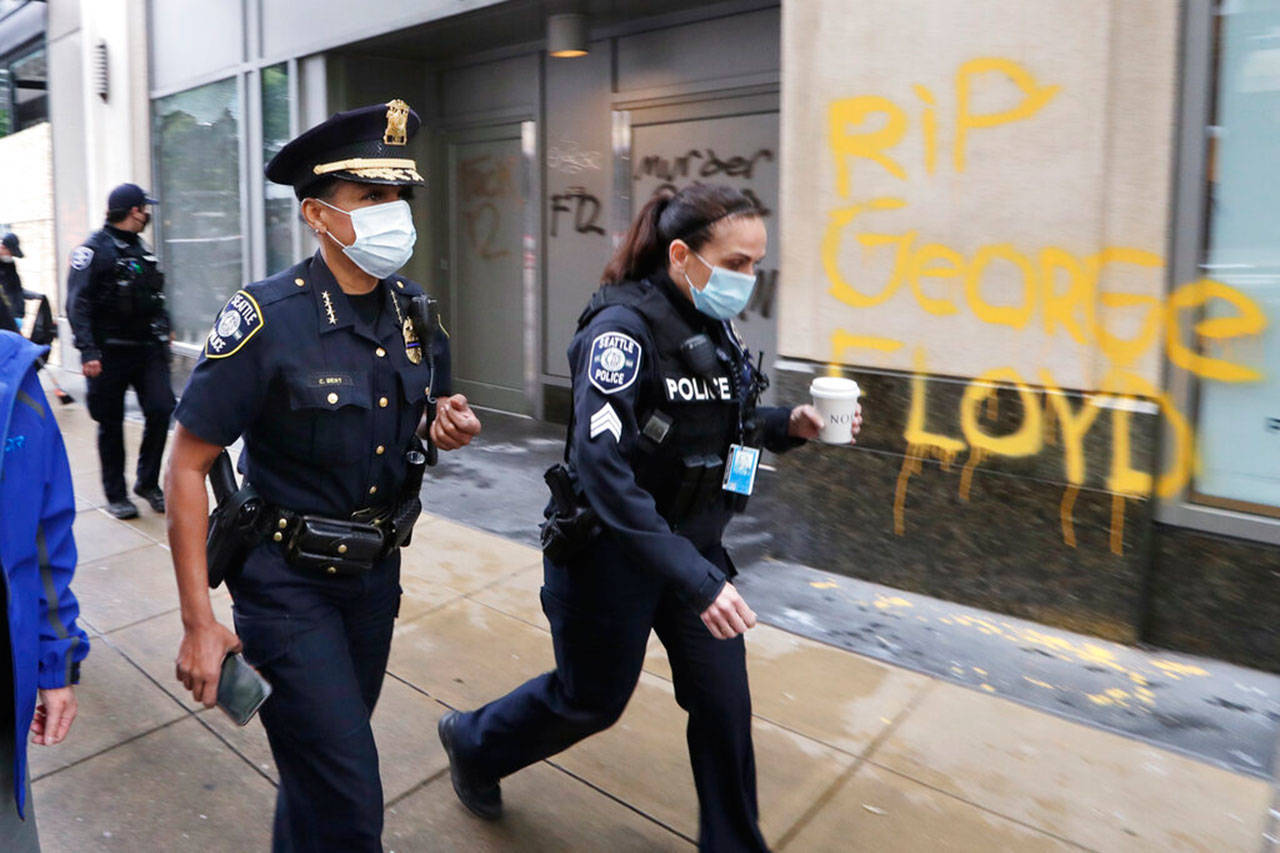By The Herald Editorial Board
As closely and as often as they communicate, law enforcement and the news media have different and separate tasks, responsibilities and public expectations; and the wall between them is there in the interests and for the protection of both.
A King County judge’s recent ruling — upholding a Seattle Police Department subpoena to compel The Seattle Times and four Seattle-area TV stations to release unpublished photos and video of Seattle’s May 30 protests — now threatens to chip away at that wall, one that has been erected by common law protections guaranteed by the First Amendment and by Washington state law.
While The Daily Herald and its parent, Sound Publishing, are not subject to the subpoena — as we had no reporters or photographers present at that protest — we object to the ruling and support a pending appeal of the judge’s order. Any weakening of that wall of separation — in effect, a forced deputizing of photographers and reporters to participate in law enforcement investigations — threatens to set a precedent for similar subpoenas in the future.
Seattle, like other cities across the nation, experienced protests — mostly peaceful but sometimes violent — following the death of George Floyd at the hands of Minneapolis police officers on May 25. One of the most violent days of protests in Seattle was on May 30, during which six police vehicles were set ablaze and from them five police firearms were stolen; two of which have not been recovered.
The Seattle Police Department in late June sought a search warrant and subpoena in King County Superior Court that would compel the Times and four TV stations — KOMO, KIRO, KING and KCPQ — to hand over any unpublished photos and video from the news media outlets taken during a 90-minute period near the scenes of the vehicle arsons and thefts to assist in the identification of suspects.
Judge Nelson Lee ruled July 23 that the news media outlets would be required to comply with the subpoena, but later ordered that the material would be reviewed by himself or a court official before being released to police.
The Times and the TV stations have until later this month to file an appeal.
While Lee’s revised order could allay concerns that Seattle Police might use the unpublished material in a “fishing expedition” to broaden the investigation’s scope to include more than the arsons and firearm thefts, it does nothing to cure the basic problem with a court order that threatens to open the door to further weakening of what are known as “press shield laws.”
Born of First Amendment press protections and case law, shield laws are in effect in all states, except for Wyoming; Washington state codified its protections with House Bill 1366, adopted as law in 2007. The law basically protects the news media from being compelled to testify, produce or disclose sources, notes, information, photos or recordings. Courts can compel disclosure of such material, but only under certain requirements, including that the information is “highly material and relevant,” “critical or necessary” to the investigation, only after all reasonable alternative sources have been exhausted, and where there is a compelling public interest in disclosure.
There are doubts the Seattle Police subpoena has met those conditions, especially as the original subpoena admits a suspect in five of the arsons, a Tacoma woman, had been identified and arrested. A second suspect has not been identified by name, but images published earlier provided a detailed description of distinctive clothing.
It’s not clear that anything that the newspaper or TV stations could turn over to police would be of much help in identifying suspects or prosecuting charges. But the perception among the public that the news media can so easily be roped in to assist in an investigation or prosecution could be damaging to the news media’s reputation for independence and impartiality and to the safety of reporters and photographers.
Reporters and photographers — already risking injury as they covered clashes between police and rioters — were subject to suspicions from both sides in protests in Seattle and in other U.S. cities. And reporters and photographers were on several occasions arrested or injured.
Seattle Times Executive Editor Michele Matassa Flores explained the danger posed to journalists:
“The masses of peaceful protesters calling for police accountability are usually happy to see media coverage of their message. But a smaller group, with some members bent on committing crimes, do not want to be captured on film. Some of them have chased our photojournalists, punched them, thrown rocks at their heads, harassed them, threatened them and posted their personal information online to instigate more harassment,” she wrote in a July 29 commentary. “When they accuse us of collaborating with law enforcement, the best we can do is state — honestly and sincerely — that we do not.”
To a few it will not matter that the news media shared such information only under court order. Beyond the physical threat, such an order risks raising doubts about the motives and independence of journalists.
State lawmakers understood the importance of the shield law they adopted to protect the press and those who gather the news. Judge Lee’s order represents the first substantial challenge to that law since it was passed 13 years ago; that challenge should not be allowed as the first crack in a necessary wall.
Talk to us
> Give us your news tips.
> Send us a letter to the editor.
> More Herald contact information.

























